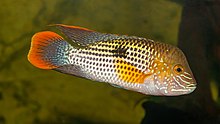| Green terror | |
|---|---|

| |

| |
| males of white-edged and gold-edged morphs | |
| Scientific classification | |
| Domain: | Eukaryota |
| Kingdom: | Animalia |
| Phylum: | Chordata |
| Class: | Actinopterygii |
| Order: | Cichliformes |
| Family: | Cichlidae |
| Genus: | Andinoacara |
| Species: | A. rivulatus |
| Binomial name | |
| Andinoacara rivulatus (Günther, 1860) | |
| Synonyms | |
The green terror (Andinoacara rivulatus, syn. Aequidens rivulatus) is a colorful freshwater fish in the cichlid family. The fish originates from the Pacific side of South America from the Tumbes River in Peru to the Esmeraldas River in Ecuador. It is polymorphic and can have white or gold-orange edging to the tail and dorsal fins. It has historically been confused with two other species that always have narrow, clearly defined white edging, the more southerly distributed A. stalsbergi (often considered the "true" green terror) and the more northerly A. blombergi.
Species
Males of A. rivulatus grow larger than females and may reach lengths of up to 30 cm (12 in). Females are sexually mature at around 12 cm (4.7 in).
As the name implies, late juvenile-phase and adult-phase specimens can be very aggressive. This is not guaranteed, however, and peaceful individuals can be observed. Juveniles of A. rivulatus are often sold in aquarium stores. This species is not to be confused with the blue acara (A. pulcher) which is similar in appearance; the blue acara is not as aggressive and does not grow as large as the gold saum.
The fish is somewhat deep-bodied, possessing a prominent forehead. Adult males develop a pronounced forehead hump, composed of fatty tissue. Juveniles are tan colored with silver-blue flecks and lack the bright iridescent blue, green, and orange coloration and long, flowing fins of adult specimens.
In nature, A. rivulatus lives in a tropical climate and prefers water with a 6.5–8.0 pH, a water hardness of 25.0 dGH, and a temperature range of 20–24 °C (68–75 °F).
In the aquarium
| This section needs additional citations for verification. Please help improve this article by adding citations to reliable sources in this section. Unsourced material may be challenged and removed. Find sources: "Green terror" – news · newspapers · books · scholar · JSTOR (May 2014) (Learn how and when to remove this message) |
A. rivulatus is a popular fish in the aquarium trade and is noted for its hardiness, as well as its aesthetic appeal. The fish may grow up to 30 cm (12 in) in length, though 15 to 20 cm (5.9 to 7.9 in) lengths are more typical, fish do not grow based on the size of their habitat.
A. rivulatus is an inherently aggressive fish. With the exception of fully mature P. dovii (wolf cichlid) and P. managuense (jaguar cichlid), which rarely cohabit peacefully, A. rivulatus is cunning enough to survive—and even thrive—with larger cichlids. However, as a rule, a preying cichlid is capable of consuming any animal whose dimensions are inferior to that of the cichlid's fully expanded jaw. A. rivulatus of an appropriate size can often be assimilated with R. octofasciata (Jack Dempsey cichlid), A. citrinellus (midas cichlid), T. meeki (firemouth cichlid), flowerhorns (no scientific designation), smaller P. managuense (jaquar cichlid) and P. dovii (wolf cichlid), and other similarly aggressive cichlids.
Role in hormone research
A. rivulatus has also been used as a model for the effects of testosterone on lateralization.
See also
References
- ^ Froese, Rainer; Pauly, Daniel (eds.). "Andinoacara rivulatus". FishBase. May 2017 version.
- Musilova, Rican, and Novak (2009). Phylogeny of the Neotropical cichlid fish tribe Cichlasomatini (Teleostei: Cichlidae) based on morphological and molecular data, with the description of a new genus. Journal of Zoological Systematics and Evolutionary Research 47(3): 209—304.
- Wijkmark, Kullander, and Barriga (2012). Andinoacara blombergi, a new species from the río Esmeraldas basin in Ecuador and a review of A. rivulatus (Teleostei: Cichlidae). Ichthyological Exploration of Freshwaters 23(2): 117—137.
- SeriouslyFish: Andinoacara rivulatus. Retrieved 7 May 2017.
- Animal-World. "Green Terror". Animal World. Retrieved 2019-02-01.
- "Green Terror – Aequidens rivulatus | Aquariums Life". Archived from the original on 2010-05-01. Retrieved 2010-02-28.
- "Green terror : care, size, lifespan, tankmates, breeding". Retrieved 2019-02-01.
- Schaafsma, Sara M.; Ton G. G. Groothuis (January 2011). "Sex-specific effects of postnatal testosterone on lateralization in cichlid fish" (PDF). Animal Behaviour. 81 (1): 283–288. doi:10.1016/j.anbehav.2010.10.019. S2CID 13931905.
- Schaafsma, Sara M.; Ton G. G. Groothuis (February 2012). "Sex-specific effects of maternal testosterone on lateralization in a cichlid fish" (PDF). Animal Behaviour. 83 (2): 437–443. doi:10.1016/j.anbehav.2011.11.015. S2CID 53188249.
General
- "Aequidens rivulatus". Integrated Taxonomic Information System. Retrieved June 22, 2005.
| Taxon identifiers | |
|---|---|
| Aequidens rivulatus | |